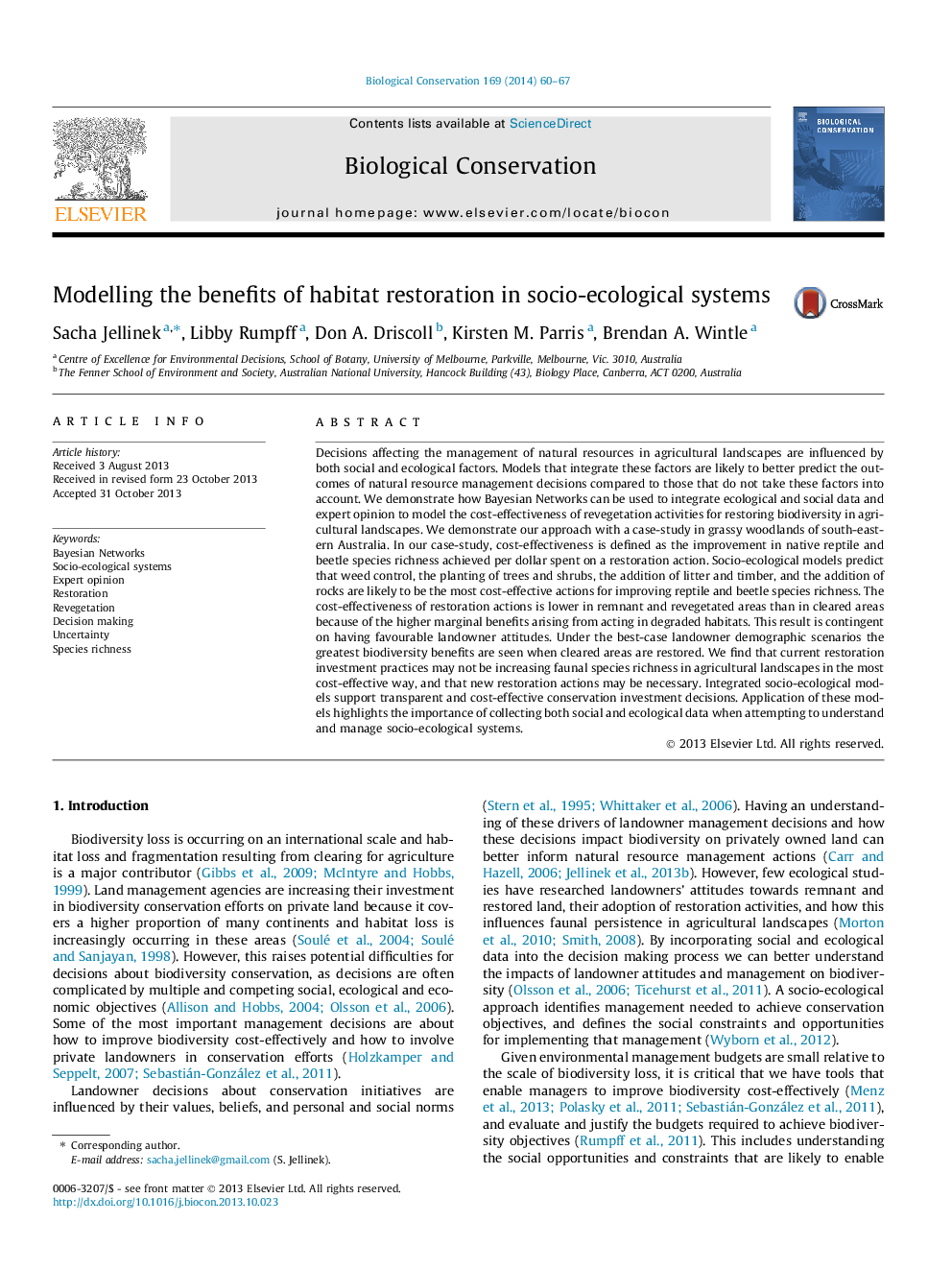| کد مقاله | کد نشریه | سال انتشار | مقاله انگلیسی | نسخه تمام متن |
|---|---|---|---|---|
| 6300389 | 1617932 | 2014 | 8 صفحه PDF | دانلود رایگان |
عنوان انگلیسی مقاله ISI
Modelling the benefits of habitat restoration in socio-ecological systems
ترجمه فارسی عنوان
مدل سازی مزایای بازسازی زیستگاه در سیستم های اجتماعی-محیطی
دانلود مقاله + سفارش ترجمه
دانلود مقاله ISI انگلیسی
رایگان برای ایرانیان
کلمات کلیدی
ترجمه چکیده
تصمیمات موثر بر مدیریت منابع طبیعی در منظرهای کشاورزی تحت تأثیر عوامل اجتماعی و زیست محیطی قرار می گیرند. مدل هایی که این عوامل را ادغام می کنند، احتمالا پیش بینی نتایج تصمیمات مدیریت منابع طبیعی را نسبت به کسانی که این عوامل را در نظر نمی گیرند، پیش بینی می کنند. ما نشان می دهیم که چگونه شبکه های بیزی برای ادغام داده های زیست شناختی و اجتماعی و نظر کارشناسانه برای مدل سازی هزینه های بهره برداری از فعالیت های بازسازی برای بازگرداندن تنوع زیستی در منظر های کشاورزی استفاده می شود. ما رویکرد ما را با مطالعه موردی در جنگلهای چمنزار جنوب شرقی استرالیا نشان می دهیم. در مطالعه موردی ما، هزینه-اثربخشی تعریف شده است به عنوان بهبود در غنای گونه خزنده بومی و سوسک به دست آمده در هر دلار صرف اقدام بازسازی. مدل های اجتماعی و اکولوژیکی پیش بینی می کنند که کنترل علف های هرز، کاشت درختان و درختچه ها، اضافه کردن بستر و چوب و اضافه کردن سنگ ها به احتمال زیاد، اقدامات ارزان تر برای بهبود غنای گونه خزنده و سوسک خواهد بود. هزینه بهره وری از اقدامات بازسازی در مناطق باقی مانده و آبرفتی شده نسبت به مناطق پاک شده به دلیل مزایای حاشیه ای ناشی از اعمال زیستگاه های زیست محیطی پایین تر است. این نتیجه مستلزم داشتن نگرش مطلوب زمین دار است. تحت بهترین سناریوهای جمعیت شناختی صاحبخانه، بیشترین مزایای تنوع زیستی در هنگام بازسازی مناطق تمیز دیده می شود. ما متوجه می شویم که اقدامات سرمایه گذاری در حال ترمیم مجدد ممکن است غنی بودن گونه های فونتی را در زمینه های کشاورزی به نحو مقرون به صرفه افزایش ندهد و اقدامات بازسازی جدید ممکن است ضروری باشد. مدل های یکپارچه اجتماعی-اکولوژیکی از تصمیمات سرمایه گذاری شفاف و مقرون به صرفه حفاظت می کند. کاربرد این مدل ها اهمیت جمع آوری داده های اجتماعی و زیست محیطی را در هنگام تلاش برای درک و مدیریت سیستم های اجتماعی-محیطی نشان می دهد.
موضوعات مرتبط
علوم زیستی و بیوفناوری
علوم کشاورزی و بیولوژیک
بوم شناسی، تکامل، رفتار و سامانه شناسی
چکیده انگلیسی
Decisions affecting the management of natural resources in agricultural landscapes are influenced by both social and ecological factors. Models that integrate these factors are likely to better predict the outcomes of natural resource management decisions compared to those that do not take these factors into account. We demonstrate how Bayesian Networks can be used to integrate ecological and social data and expert opinion to model the cost-effectiveness of revegetation activities for restoring biodiversity in agricultural landscapes. We demonstrate our approach with a case-study in grassy woodlands of south-eastern Australia. In our case-study, cost-effectiveness is defined as the improvement in native reptile and beetle species richness achieved per dollar spent on a restoration action. Socio-ecological models predict that weed control, the planting of trees and shrubs, the addition of litter and timber, and the addition of rocks are likely to be the most cost-effective actions for improving reptile and beetle species richness. The cost-effectiveness of restoration actions is lower in remnant and revegetated areas than in cleared areas because of the higher marginal benefits arising from acting in degraded habitats. This result is contingent on having favourable landowner attitudes. Under the best-case landowner demographic scenarios the greatest biodiversity benefits are seen when cleared areas are restored. We find that current restoration investment practices may not be increasing faunal species richness in agricultural landscapes in the most cost-effective way, and that new restoration actions may be necessary. Integrated socio-ecological models support transparent and cost-effective conservation investment decisions. Application of these models highlights the importance of collecting both social and ecological data when attempting to understand and manage socio-ecological systems.
ناشر
Database: Elsevier - ScienceDirect (ساینس دایرکت)
Journal: Biological Conservation - Volume 169, January 2014, Pages 60-67
Journal: Biological Conservation - Volume 169, January 2014, Pages 60-67
نویسندگان
Sacha Jellinek, Libby Rumpff, Don A. Driscoll, Kirsten M. Parris, Brendan A. Wintle,
